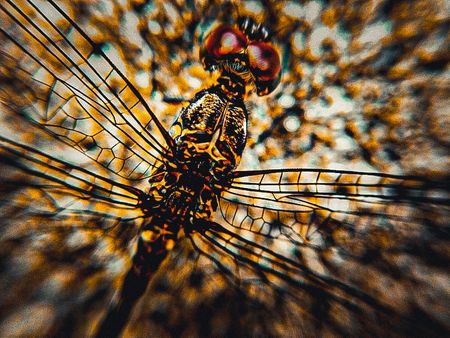PERABEATS
 shehan
shehan9/5/2023
PERABEATS LIFE The story of the dragonfly Sri Lanka is a unique and mind-blowing island with special environments and a biological hotspot, home to many amazing creatures that meet the eye. In all terrestrial and aquatic ecosystems and fauna, they are a very prominent group of animals. The common nomenclature of this animal, which is the dragonfly, belongs to the Odonata (Odonata) tribe (oder). It is home to coastal to wetland and talava ecosystems, from wet to dry land, from tropical rain forest to dry mixed evergreen forest. Dragonflies in Sri Lanka are diverse in both wet and dry zones and all have common and unique behavior patterns. The behavior of dragonflies adapted after many eras created by time is quite amazing. Fossil signs have been found that this carnivore, which was very prolific during the Carboniferous period, had a wingspan of one and a half feet or more. Considering the biological conditions of Sri Lanka, 38.4% of the species found in the country are known as endemic species. The origin and evolution of this animal, which reduces its size when the percentage of oxygen concentration on the earth decreases from 30% to the current value of 21%, runs to the Carboniferous period millions of years ago, but only the size has remained in the current state, subject to change over time. When the sub-tribes of Zygoptera and Anisoptera are taken in the Odonata tribe, even their external form changes so that they can be identified. The third part (Meta thorax) is connected to a pair of wings each. Because there are wings (Wings), although it is in the sub-type of Pterygota (Sub Oder), because the wings cannot be folded back and on the abdomen, the organisms are divided again into Paleoptera (Paleoptera) according to the classification hierarchy. This animal, which has three pairs of legs for the thoracic segments, uses its front pair almost always to clean the mouth and also to clean the pair of eyes for clearer vision, and the second and third pairs of legs are used to hold the surface tightly. Cetaceans, which are very short on the head, have tactile and mouth apparatuses that are adapted for biting (mandibulate type) to express their innate endowment to grab prey from their food. There is a pair of compound eyes, which consist of 25000-35000 ommatidia, but each of these ommatidia, which is very sensitive to movement, creates images and corrects them by the brain. The abdomen consists of about ten segments, and some of them have structures called spiracles. These are air exchange windows and are adaptations designed to obtain the oxygen needed for the flight muscles with high efficiency. Although they can be clearly distinguished by body color patterns and wing patterns, they are similar but different species of dragonflies live in small numbers. Therefore, even male and female animals can be seen as two species except in a very close observation. The value of a system in an aquatic ecosystem. Further evolving, this amazing animal adaptively chooses air and terrestrial environments for part of its life cycle being aquatic and the rest. Animals such as Sinhalestes orientalis are considered endemic to Sri Lanka and rare species such as Mycrogomphus Wijaya are also reported from Sri Lanka. This animal, which shows promiscuity even in the form of egg-laying, often chooses moist plant stems and wet ground immediately above the surface of running water, still water. Some types of still water, some types of running water and some types of brackish water are chosen for their larval stage, but for this animal that lives in a cell for a considerable period of its life in an aquatic ecosystem, the most suitable environment for it to come out of its cell and live is wetlands. Because the availability of food is guaranteed in a place with still water. In the larval stage, small insects also have an interest in eating very small fish fry and small-sized shrimps. These wonderful links that allow the recycling of materials through food chains and food webs are carnivores in their own specialty. They also exhibit autophagous food patterns, eating organisms. Despite their evolutionary dominance on the earth, they are also a tasty food for some carnivores. Spiders, frogs and snakes are known as their fierce predators. Through their carnivorous lifestyle, they help the farmer and the gardener, although they are not intelligently adapted by nature. This amazing creature, which has conquered all three environments, aquatic and terrestrial, due to its adaptations, is precious to the environment then and now and tomorrow.








PERABEATS LIFE The story of the dragonfly Sri Lanka is a unique and mind-blowing island with special environments and a biological hotspot, home to many amazing creatures that meet the eye. In all terrestrial and aquatic ecosystems and fauna, they are a very prominent group of animals. The common nomenclature of this animal, which is the dragonfly, belongs to the Odonata (Odonata) tribe (oder). It is home to coastal to wetland and talava ecosystems, from wet to dry land, from tropical rain forest to dry mixed evergreen forest. Dragonflies in Sri Lanka are diverse in both wet and dry zones and all have common and unique behavior patterns. The behavior of dragonflies adapted after many eras created by time is quite amazing. Fossil signs have been found that this carnivore, which was very prolific during the Carboniferous period, had a wingspan of one and a half feet or more. Considering the biological conditions of Sri Lanka, 38.4% of the species found in the country are known as endemic species. The origin and evolution of this animal, which reduces its size when the percentage of oxygen concentration on the earth decreases from 30% to the current value of 21%, runs to the Carboniferous period millions of years ago, but only the size has remained in the current state, subject to change over time. When the sub-tribes of Zygoptera and Anisoptera are taken in the Odonata tribe, even their external form changes so that they can be identified. The third part (Meta thorax) is connected to a pair of wings each. Because there are wings (Wings), although it is in the sub-type of Pterygota (Sub Oder), because the wings cannot be folded back and on the abdomen, the organisms are divided again into Paleoptera (Paleoptera) according to the classification hierarchy. This animal, which has three pairs of legs for the thoracic segments, uses its front pair almost always to clean the mouth and also to clean the pair of eyes for clearer vision, and the second and third pairs of legs are used to hold the surface tightly. Cetaceans, which are very short on the head, have tactile and mouth apparatuses that are adapted for biting (mandibulate type) to express their innate endowment to grab prey from their food. There is a pair of compound eyes, which consist of 25000-35000 ommatidia, but each of these ommatidia, which is very sensitive to movement, creates images and corrects them by the brain. The abdomen consists of about ten segments, and some of them have structures called spiracles. These are air exchange windows and are adaptations designed to obtain the oxygen needed for the flight muscles with high efficiency. Although they can be clearly distinguished by body color patterns and wing patterns, they are similar but different species of dragonflies live in small numbers. Therefore, even male and female animals can be seen as two species except in a very close observation. The value of a system in an aquatic ecosystem. Further evolving, this amazing animal adaptively chooses air and terrestrial environments for part of its life cycle being aquatic and the rest. Animals such as Sinhalestes orientalis are considered endemic to Sri Lanka and rare species such as Mycrogomphus Wijaya are also reported from Sri Lanka. This animal, which shows promiscuity even in the form of egg-laying, often chooses moist plant stems and wet ground immediately above the surface of running water, still water. Some types of still water, some types of running water and some types of brackish water are chosen for their larval stage, but for this animal that lives in a cell for a considerable period of its life in an aquatic ecosystem, the most suitable environment for it to come out of its cell and live is wetlands. Because the availability of food is guaranteed in a place with still water. In the larval stage, small insects also have an interest in eating very small fish fry and small-sized shrimps. These wonderful links that allow the recycling of materials through food chains and food webs are carnivores in their own specialty. They also exhibit autophagous food patterns, eating organisms. Despite their evolutionary dominance on the earth, they are also a tasty food for some carnivores. Spiders, frogs and snakes are known as their fierce predators. Through their carnivorous lifestyle, they help the farmer and the gardener, although they are not intelligently adapted by nature. This amazing creature, which has conquered all three environments, aquatic and terrestrial, due to its adaptations, is precious to the environment then and now and tomorrow.


-
Terms and Conditions-
Privacy Policy-
Payments Policy-
Disclaimer-
Refunds & Return Policy-
Contact UsKunda Box Corp, All rights Reserved
Comments